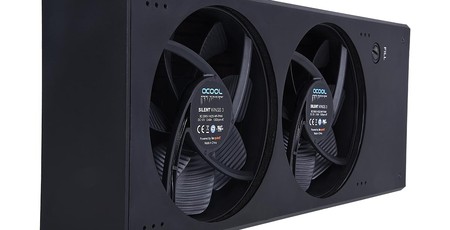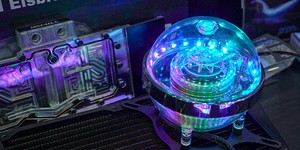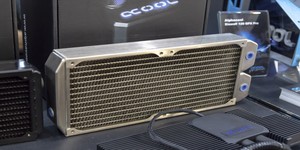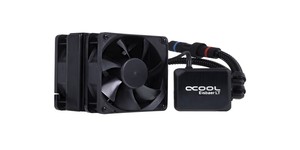
Manufacturer: Alphacool
UK price (as reviewed): £167.80 (inc. VAT)
US price (as reviewed): $283.49 (exc. tax)
You're likely familiar with the various AIO liquid-coolers out there right now, but in general they fall into two groups. Firstly you have those that sit directly above air coolers in terms of their specifications. They have fairly low-power pumps often made by the likes of Asetek and are generally non-expandable, and it can be hit or miss as to whether they perform well or remain quiet. The other group is made up of custom liquid-cooling components that borrow pumps, water blocks, or radiators from existing product lines and as a result are often powerful, expandable, and offer similar performance to a proper custom liquid-cooling loop. The Alphacool Eisbaer Extreme 280 falls into the latter group, and it's one of the biggest AIO liquid-coolers we've ever seen.

In fact, it's so big that it wouldn't fit into our Corsair Graphite 730 case, which isn't exactly small, so we had to unleash our Dremel to do away with some unwanted optical drive bays. However, while few cases have these now, the blame still rests mostly at Alphacool's feet here, as the radiator section of the Eisbaer Extreme 280 is enormous. It's nearly 400mm long and 64mm deep, and with a gargantuan width of nearly 160mm finding a case that can house it will likely be a challenge in itself. The Corsair H150i Pro is certainly longer, but its radiator looks positively skinny compared to the combined reservoir, pump, fans and radiator unit here.

Cooling your CPU is an Alphacool Eisblock XPX, which supports all current CPU sockets including Socket TR4 plus plenty of older ones too including LGA 1366, although LGA 775 isn't on the list (upgrade already!). Installation is relatively simple, but Alphacool's mounting mechanism is a little archaic and fiddly with springs, screws, and washers to deal with and even nuts on mainstream sockets. It's difficult to go wrong, though, and the manual is decent enough with large colour diagrams, so even a liquid-cooling newcomer should sail through.

The water block sports a blue LED light illuminating the Alphacool logo on top courtesy of a three-pin power cable, with metal clips hooking onto each side catering for AMD and Intel sockets. The water block section is detachable thanks to quick-release fittings on the tubes, which unscrew and allow you to add other components or just detach the water block for easier fitting without draining the loop.

The reservoir is illuminated by LEDs too with a see-through section on one side of the radiator. However, we found the only way most cases will accept the radiator, at least in the roof, is to have the ports at the front of the case, as the tubing was prone to kinking if we mounted the radiator with the tubes at the rear of the case and bent them around to the CPU socket. This hasn't generally been an issue with other AIO liquid-coolers, which often use smaller but more kink-proof tubing.

The exterior shell can be dismantled, although it's a fiddle to get it back together again. If you take a look at the fill port, you'll see Alphacool's new G1/4in plugs, which we first saw at CES. These sit flush with the radiator housing and don't further add to the dimensions you need to deal with. You'll likely need to top up the loop every now and then, especially when adding components to the loop.

Popping off the top of the radiator section reveals the reservoir and pump along with LEDs, and further in is an Alphacool 280mm NexXxos Radiator that's 30mm thick. On top of the metal shroud are the tube ports, a grommeted hole feeding out the Molex power connector for the pump, a speed readout, and a PWM control cable for the two included 140mm Be Quiet! Silent Wings 3 fans.

Rather than opt for its low-power and rather whiny DC-LT pump, Alphacool has made the wise choice of using its variation of the Laing D5, called the Eispumpe-VPP755. This actually sports the same variable control as you'd find on the Laing D5 Vario, but sadly this dial is tricky to get at, as you need to remove the radiator housing. As standard the pump was set to full speed and honestly was inaudible sat next to the fans with Alphacool claiming it offered flow rates of up to 340 litres an hour. This is about a quarter of what a full-speed Laing D5 is capable of, but as anyone that's used that pump will attest to, using at full speed amounts to a whole lot more noise and no extra cooling. In any event, seeing what a pain it was to get inside and adjust this dial, we've carried out all tests with the pump at full speed.

Specifications
- Compatibility Intel: LGA 20xx, LGA 115x, LGA 1366 AMD: Socket TR4, Socket AM4, Sockets AM3(+)/AM2(+)/FM2(+)/FM1
- Radiator size (mm) 385 x 156 x 64 (W x D x H)
- Fan(s) 2 x Be Quiet! Silent Wings 3 140mm PWM, up to 1,300 RPM
- Fan size (mm) 25 x 140 x 140
- Stated noise 31 dB(A)
- Extras Thermal paste tube

MSI MPG Velox 100R Chassis Review
October 14 2021 | 15:04








Want to comment? Please log in.